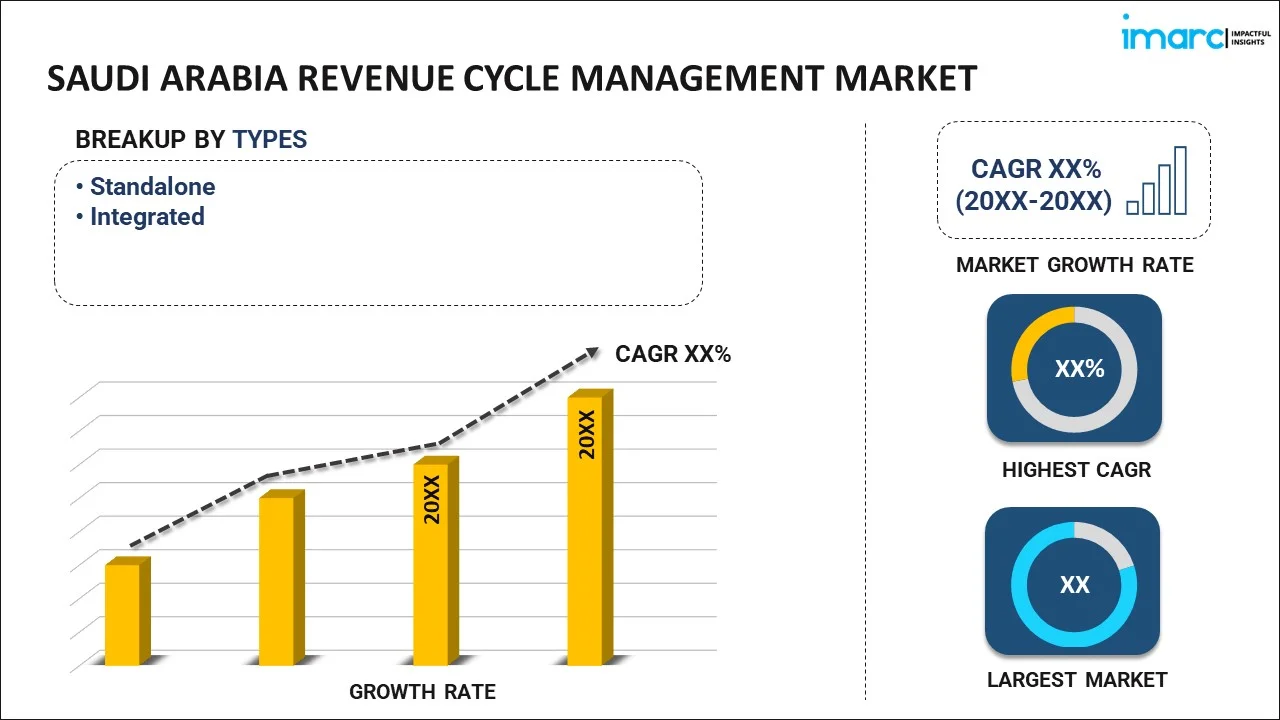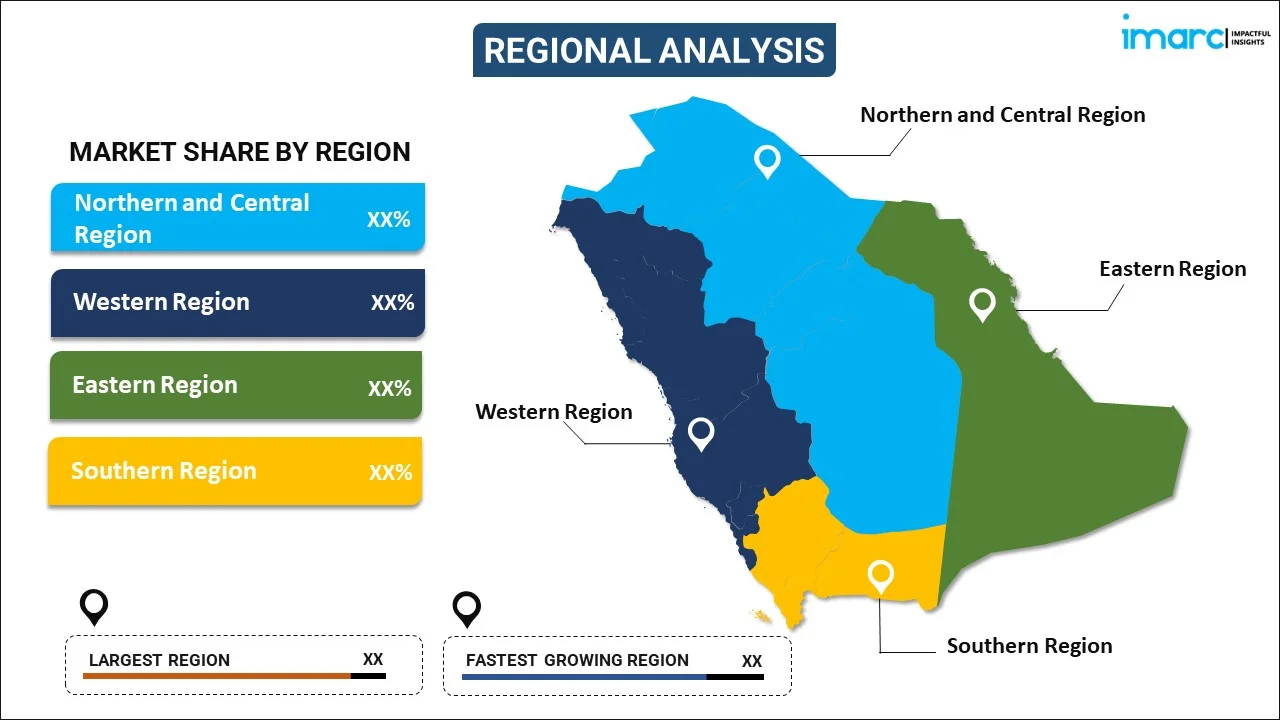
Saudi Arabia Revenue Cycle Management Market Report by Type (Standalone, Integrated), Component (Software, Services), Deployment (Web-based, Cloud-based, On-premises), End User (Hospitals, Physicians, Diagnostic and Ambulatory Care Centers), and Region 2025-2033
Market Overview:
Saudi Arabia revenue cycle management market size reached USD 1,382.0 Million in 2024. The market is projected to reach USD 3,762.1 Million by 2033, exhibiting a growth rate (CAGR) of 11.77% during 2025-2033. The increasing advances in technology, including the use of artificial intelligence, machine learning, and data analytics, which have improved the efficiency and accuracy of revenue cycle management processes, are driving the market.
|
Report Attribute
|
Key Statistics
|
|---|---|
|
Base Year
|
2024
|
|
Forecast Years
|
2025-2033
|
|
Historical Years
|
2019-2024
|
|
Market Size in 2024
|
USD 1,382.0 Million |
|
Market Forecast in 2033
|
USD 3,762.1 Million |
| Market Growth Rate 2025-2033 | 11.77% |
Revenue cycle management (RCM) is a systematic approach that healthcare organizations use to track the entire lifespan of a patient's interaction, from appointment scheduling to final payment collection. It involves managing administrative and clinical functions related to billing, claims processing, and revenue generation. RCM aims to optimize financial performance by ensuring accurate and timely reimbursement for services provided. Key components include patient registration, insurance verification, charge capture, coding, claims submission, and payment posting. Effective RCM reduces billing errors, accelerates cash flow, and enhances overall operational efficiency. Automation and technology play crucial roles in streamlining processes, minimizing human errors, and improving the overall financial health of healthcare institutions. By focusing on the entire revenue cycle, organizations can enhance patient satisfaction, compliance, and financial sustainability.
Saudi Arabia Revenue Cycle Management Market Trends:
Increasing Healthcare Spending
With significant investments in enhancing the healthcare infrastructure in Saudi Arabia, healthcare providers encounter increasing patient numbers and more complex services. In 2025, Saudi Arabia declared a $69.3 billion investment aimed at improving its healthcare system under the Vision 2030 initiative, which involves constructing five hospitals, boosting emergency and preventive services, and integrating digital technologies like artificial intelligence (AI) and telemedicine. This increase in expenditure on infrastructure, healthcare technologies, and services leads to a higher volume of transactions and claims to manage, heightening the need for effective RCM solutions. To match this expansion, providers look for sophisticated RCM systems that can handle high volumes of claims, lower operational expenses, and guarantee prompt reimbursements, all of which are essential for navigating a fast-changing healthcare environment.
Growing Patient Volume and Service Utilization
Saudi Arabia's expanding population, along with better access to healthcare and increased awareness, is leading to a rise in patient numbers and service use in healthcare facilities. By mid-2024, the General Authority for Statistics projects the population of the Kingdom to be 35.3 million individuals, leading to a higher demand for medical services, especially in cities. The increase in patient numbers is making claims, medical records, and billing procedures more intricate, necessitating that healthcare providers manage larger amounts of claims effectively. To address these challenges, healthcare providers are implementing sophisticated RCM systems that can streamline billing, coding, and claims submission. These systems assist in optimizing workflows, enhancing precision, minimizing processing duration, and improving reimbursement possibilities. By incorporating automated RCM solutions, providers can efficiently handle the heightened workload while maintaining service quality and operational efficiency amidst rising demand.
Rise in Medical Tourism
Saudi Arabia's expanding medical tourism industry is a crucial factor driving the demand for RCM solutions. The medical tourism sector in Saudi Arabia is projected to hit USD 1,341.1 million in 2024 and is anticipated to expand to USD 7,918.6 million by 2033, with a CAGR of 21.80%, positioning the Kingdom, highlighting the kingdom as a top choice for pursuing specialized care. With the growth of medical tourism, healthcare providers need to manage not just local but also global patient billing, which includes dealing with various insurance plans, currency exchanges, and international payment systems. Conventional billing approaches frequently find it challenging to address these complexities, highlighting the growing necessity for advanced RCM systems capable of handling multi-currency transactions, international insurance claims, and intricate financial dealings. To remain competitive on a global scale, healthcare organizations are implementing RCM solutions that provide the necessary flexibility, precision, and scalability to meet the increasing demand and guarantee effective financial management in this developing industry.
Saudi Arabia Revenue Cycle Management Market Segmentation:
IMARC Group provides an analysis of the key trends in each segment of the market, along with forecasts at the country level for 2025-2033. Our report has categorized the market based on type, component, deployment, and end user.
Type Insights:

- Standalone
- Integrated
The report has provided a detailed breakup and analysis of the market based on the type. This includes standalone and integrated.
Component Insights:
- Software
- Services
A detailed breakup and analysis of the market based on the component have also been provided in the report. This includes software and services.
Deployment Insights:
- Web-based
- Cloud-based
- On-premises
The report has provided a detailed breakup and analysis of the market based on the deployment. This includes web-based, cloud-based, and on-premises.
End User Insights:
- Hospitals
- Physicians
- Diagnostic and Ambulatory Care Centers
A detailed breakup and analysis of the market based on the end user have also been provided in the report. This includes hospitals, physicians, and diagnostic and ambulatory care centers.
Regional Insights:

- Northern and Central Region
- Western Region
- Eastern Region
- Southern Region
The report has also provided a comprehensive analysis of all the major regional markets, which include Northern and Central Region, Western Region, Eastern Region, and Southern Region.
Competitive Landscape:
The market research report has also provided a comprehensive analysis of the competitive landscape. Competitive analysis such as market structure, key player positioning, top winning strategies, competitive dashboard, and company evaluation quadrant has been covered in the report. Also, detailed profiles of all major companies have been provided.
Saudi Arabia Revenue Cycle Management Market News:
- In April 2025, Under Vision 2030, Saudi Arabia is transforming Revenue Cycle Management through NPHIES, a national health information exchange platform. It streamlines claims, standardizes data, and enhances financial forecasting, enabling faster, more accurate reimbursements. Healthcare providers must adapt with tech upgrades and staff training.
- In May 2024, Ecaresoft and Accumed partnered to modernize Revenue Cycle Management for outpatient care centers in Saudi Arabia. By integrating Ecaresoft’s digital healthcare platform with Accumed’s RCM expertise, the alliance aimed to boost efficiency, reduce claim rejections, and enhance patient care.
Saudi Arabia Revenue Cycle Management Market Report Coverage:
| Report Features | Details |
|---|---|
| Base Year of the Analysis | 2024 |
| Historical Period | 2019-2024 |
| Forecast Period | 2025-2033 |
| Units | Million USD |
| Scope of the Report | Exploration of Historical Trends and Market Outlook, Industry Catalysts and Challenges, Segment-Wise Historical and Future Market Assessment:
|
| Types Covered | Standalone, Integrated |
| Components Covered | Software, Services |
| Deployments Covered | Web-based, Cloud-based, On-premises |
| End Users Covered | Hospitals, Physicians, Diagnostic and Ambulatory Care Centers |
| Regions Covered | Northern and Central Region, Western Region, Eastern Region, Southern Region |
| Customization Scope | 10% Free Customization |
| Post-Sale Analyst Support | 10-12 Weeks |
| Delivery Format | PDF and Excel through Email (We can also provide the editable version of the report in PPT/Word format on special request) |
Key Benefits for Stakeholders:
- IMARC’s industry report offers a comprehensive quantitative analysis of various market segments, historical and current market trends, market forecasts, and dynamics of the Saudi Arabia revenue cycle management market from 2019-2033.
- The research report provides the latest information on the market drivers, challenges, and opportunities in the Saudi Arabia revenue cycle management market.
- Porter's five forces analysis assist stakeholders in assessing the impact of new entrants, competitive rivalry, supplier power, buyer power, and the threat of substitution. It helps stakeholders to analyze the level of competition within the Saudi Arabia revenue cycle management industry and its attractiveness.
- Competitive landscape allows stakeholders to understand their competitive environment and provides an insight into the current positions of key players in the market.
Key Questions Answered in This Report
Revenue cycle management involves handling the financial elements associated with healthcare services, ranging from patient registration to payment collection. It includes tasks like billing, coding, insurance verification, and claims follow-up. It guarantees that healthcare providers are reimbursed properly for services rendered, optimizing revenue and minimizing financial errors and delays.
The revenue cycle management market in the Saudi Arabia was valued at USD 1,382.0 Million in 2024.
The Saudi Arabia revenue cycle management market is projected to exhibit a CAGR of 11.77% during 2025-2033, reaching a value of USD 3,762.1 Million by 2033.
Key factors driving the Saudi Arabia revenue cycle management market include the growing demand for efficient healthcare services, increasing adoption of digital health technologies, and the need for improved financial processes. Additionally, government initiatives to enhance healthcare infrastructure and regulations supporting transparency and accountability contribute to the market growth and development.
Need more help?
- Speak to our experienced analysts for insights on the current market scenarios.
- Include additional segments and countries to customize the report as per your requirement.
- Gain an unparalleled competitive advantage in your domain by understanding how to utilize the report and positively impacting your operations and revenue.
- For further assistance, please connect with our analysts.
 Request Customization
Request Customization
 Speak to an Analyst
Speak to an Analyst
 Request Brochure
Request Brochure
 Inquire Before Buying
Inquire Before Buying




.webp)




.webp)












